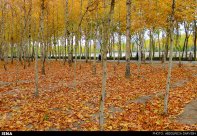Isfahan was once one of the largest cities in the world. It flourished from 1050 to 1722, particularly in the 16th century under the Safavid dynasty. Even today, the city retains much of its past glory. It is famous for its Persian–Islamic architecture, with many beautiful boulevards, covered bridges, palaces, mosques, and minarets. This led to the Persian proverb “Esfahān nesf-e- jahān ast” (Isfahan is half of the world).
The Naghsh-e Jahan Square in Isfahan is one of the largest city squares in the world and an outstanding example of Iranian and Islamic architecture. It has been designated by UNESCO as a World Heritage Site. The city also has a wide variety of historic monuments and is known for the paintings, history and architecture.
Photo gallery: Beautiful pictures of Isfahan in autumn
Today Isfahan is the capital of Isfahan Province and with a population of 1,755,382 inhabitants is also Iran’s third largest city after Tehran and Mashhad. The city is located 340 kilometres south of Tehran, in the lush plain of the Zayanderud River, at the foothills of the Zagros mountain range.
The nearest mountain is Mount Soffeh (Kuh-e Soffeh) which is situated just south of Isfahan, at 1,590 metres (5,217 ft) above sea level on the eastern side of the Zagros Mountains. Isfahan has an arid climate but despite its altitude, the city remains hot during the summer. However, with low humidity and moderate temperatures at night, the climate can be very pleasant.
Source: Wikipedia | Isfahan, ISNA I, ISNA II, ISNA III, Borna News I, Borna News II



















